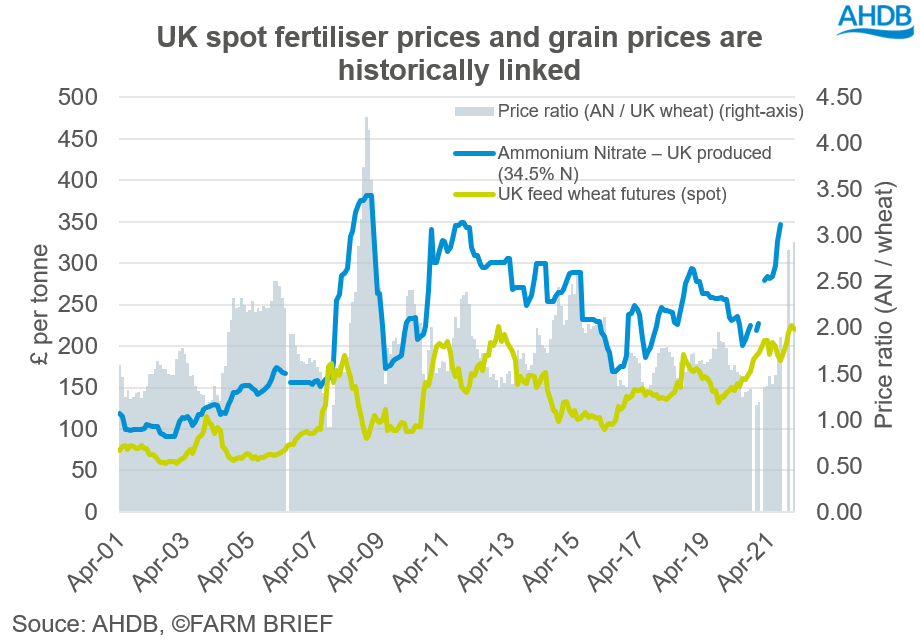- Location
- Stoneleigh
In the last two weeks commodity markets have risen sharply, but amongst these high prices are now ever higher input costs for farm businesses. In this article I want to discuss what is driving fertiliser prices and present tools and guidance from the AHDB to help with business decisions for managing this cost.
Further to that, information on adjusting N rates and alternative fertiliser management options can be found in Georgina Key (Resource Management Scientist) blog.
In response to high gas prices Yara announced on Wednesday 09 March that its European ammonia and urea production is anticipated to operate at approximately 45% capacity by the end of this week.
This news, combined with the Russian news outlined in the market commentary, will have implications globally. Higher fertiliser prices mean costs of production globally will increase, which could alter which crops are grown or crops are grown on marginal land. Also, the quality of grain (such as milling wheat) may well be reduced if fertiliser input is reduced. Finally, yields could be lower if farmers choose or are forced to reduce fertiliser applications, potentially impacting global production.

As shown in the graph above there is a relationship between domestic AN prices and UK feed wheat futures. Based on the last 20 years, AN is usually 1.5-2.0 times the price of wheat. However, anomalies do exist such as the end of 2008 and right now.
High grain prices currently are absorbing an element of these increased input costs, but not all. What’s more, the time is approaching to procure fertiliser for harvest 2023. Knowing your potential cost of production with these increased input costs is key for knowing when it’s a good time to market your grain.
Today's Grain Market Daily on our website: High prices but high fertiliser cost
For information on price direction make sure to subscribe to Grain Market Daily and Market Report from our team.
Tools
With input costs such as fertiliser rising, the latest nutrient management guide (RB209) update on the AHDB website could help your business adapt to this increase. This will help you make the most of organic materials and balance the benefits of fertiliser use against the costs, both economically and environmentally. Also, our nitrogen fertiliser adjustment calculator tool enables you to adjust the amount of nitrogen to apply to cereals and/or oilseeds crops, depending on commodity prices.Further to that, information on adjusting N rates and alternative fertiliser management options can be found in Georgina Key (Resource Management Scientist) blog.
Rising fertiliser costs
The Russian-Ukrainian war has caused large volatility in grain markets, as the market commentary above outlines. The conflict is also supporting energy market significantly, as outlined in recent analysis:- A summary of the impacts of the Russian invasion of Ukraine on energy markets
- Fuel feels the burn on further sanction tensions: Grain market daily
In response to high gas prices Yara announced on Wednesday 09 March that its European ammonia and urea production is anticipated to operate at approximately 45% capacity by the end of this week.
This news, combined with the Russian news outlined in the market commentary, will have implications globally. Higher fertiliser prices mean costs of production globally will increase, which could alter which crops are grown or crops are grown on marginal land. Also, the quality of grain (such as milling wheat) may well be reduced if fertiliser input is reduced. Finally, yields could be lower if farmers choose or are forced to reduce fertiliser applications, potentially impacting global production.
UK focus
In January spot AN – UK produced averaged £645.00/t in our GB fertiliser prices survey. Since this point though, anecdotally AN prices have been rising further.
As shown in the graph above there is a relationship between domestic AN prices and UK feed wheat futures. Based on the last 20 years, AN is usually 1.5-2.0 times the price of wheat. However, anomalies do exist such as the end of 2008 and right now.
High grain prices currently are absorbing an element of these increased input costs, but not all. What’s more, the time is approaching to procure fertiliser for harvest 2023. Knowing your potential cost of production with these increased input costs is key for knowing when it’s a good time to market your grain.
Today's Grain Market Daily on our website: High prices but high fertiliser cost
For information on price direction make sure to subscribe to Grain Market Daily and Market Report from our team.





